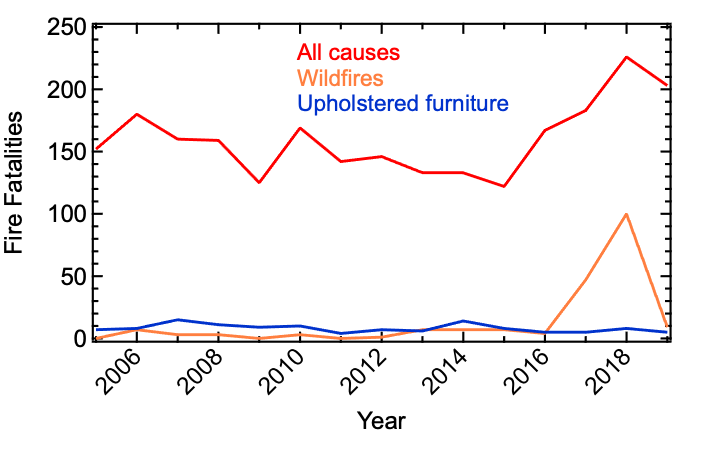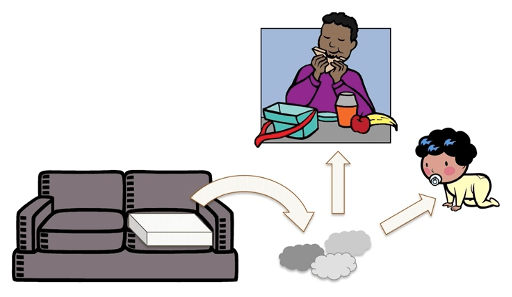Webinar Recap: Purchasing Fire-Safe Healthier Furniture
By Lydia Jahl | October 22, 2021
On October 19, we hosted a webinar along with the Center for Environmental Health and Health Care Without Harm. We updated purchasers and designers in healthcare, government, private business, hospitality, and education on changes in furniture flammability standards and concerns for the future. Read on for a summary of Green Science Policy's presentation in the webinar, and view the full recording featuring our excellent speakers here.
For nearly 40 years, furniture in the U.S. and Canada contained toxic flame retardant chemicals to meet an ineffective California furniture flammability standard called Technical Bulletin 117 (TB117). These harmful chemicals escaped from furniture foam, ending up in our homes and our bodies, reducing our children’s IQs, and increasing cancer, neurological, reproductive, immune, and other health problems across our population.
In 2014, the old open flame standard was updated to a new smolder furniture flammability standard called TB117-2013. This standard prevents fires from the major cause of ignition (smoldering sources such as cigarettes and space heaters) resulting in a decrease in fires and flame retardant usage — a win-win for both fire safety and public health. In June 2021, the California standard was adopted as the new U.S. national furniture flammability standard. Furniture manufacturers, firefighters, and public health experts all welcomed this change.
OLD: Open Flame Standard (TB117)
- Foam inside of furniture required to withstand a small open flame for 12 seconds without igniting
- Open flame fires are uncommon and real fires start on furniture surfaces rather than within the foam
- Met with harmful flame retardants that migrate out of furniture and into dust which can then be ingested by people and animals
- Flame retardants as used to meet TB117 did not improve fire safety because once flames reach the internal foam, the flame retardants cannot prevent ignition
NEW: Smolder Standard (TB117-2013)
- Furniture required to withstand a smoldering fire source
- Can be met without added flame retardants, though the use of flame retardants is not banned
- Addresses the major causes of upholstered furniture fires such as smoldering cigarettes, space heaters, or other smoldering sources
- Prevents most fabric ignitions which protects flammable foam
What does the nationwide adoption of TB117-2013 mean?
This smolder standard prevents the most common causes of upholstered furniture fires such as smoldering cigarettes and space heaters. At the same time, it can be met without flame retardants, making furniture both safer and healthier across the United States. Note that while there is a new national standard, designers should always consult their local fire code, as some jurisdictions may have different requirements for unsprinklered high-occupancy spaces.
However, organizations who stand to profit from open flame tests and the use of flame retardants continue to advocate for them. Examples of their misleading claims are below.
CLAIM: Fire deaths have increased since California updated its furniture flammability standard.
FACT: The increase in total fire fatalities in California over the past few years is due to an increase in wildfire incidents rather than upholstered furniture fires. There has been no increase in fatalities due to fires where upholstered furniture was the first item ignited or contributed most to the spread of the fire. See the graph below for relevant data.

CLAIM: Fire death rates in living rooms and bedrooms doubled in the past 40 years.
FACT: The total number of living room and bedroom fire deaths has actually decreased over 50% compared to 40 years ago.1 This sharp decrease in number leads to an increase in the apparent rate of fire deaths per 1,000 living room and bedroom fires. Industry uses this this rate based off of fires, not population, making the problem seem worse than it is. In reality, today we have fewer fire deaths, and there is no evidence that today’s furniture is less safe than it was 40 years ago.
CLAIM: Adding flame retardants into products is worth it, even just to save a few lives per year.

FACT: Fire safety data do not support the claim that flame retardants save lives. The chemicals migrate out of furniture and into dust which is then ingested by people and pets. Studies of people in areas with open flame standards show higher levels of toxic flame retardants in their bodies.2-3 Exposure is associated with cancer and neurological, reproductive, immune, and developmental problems.4-7 Toddlers have 3 to 10 times the flame retardant levels of adults, which can harm their developing brains and reproductive organs at a most vulnerable time.8-9 Furthermore, when products with flame retardants burn, there is even more toxic smoke which impedes escape.

CLAIM: Meeting both open flame and smolder standards makes furniture safer.
FACT: Companies that profit by conducting flammability tests promote the use of both open flame and smolder standards. They claim that furniture barriers without flame retardants may be used to meet open flame standards, but in reality, this option is very difficult and costly. In order for manufacturers to be cost competitive, flame retardants are most likely to be used, just as they were to meet TB117. The switch to a smolder standard has improved fire safety while reducing the use of harmful chemicals. Be wary of suggestions to revert to open flame standards, especially from those who might profit from them.
CLAIM: Newer flame retardants are safe to use.
FACT: Many halogenated (containing chlorine or bromine) flame retardants have been phased out of use, but newer phosphorus-based flame retardants are also harmful to human and environmental health. Organophosphate ester flame retardants, the most common replacement, have been found at much greater concentrations than old brominated flame retardants in the environment and in indoor dust and have similar health harms.10-11 Other new types of flame retardants claimed as safe are made of harmful components, and their fire-safety benefits and lack of toxicity have not been proven.12-13 We should not repeat mistakes of using chemicals before proving their safety and effectiveness.
Proven safety measures for a fire-safe and healthy home
- Ensure presence of working fire detectors and alarms
- Keep fire extinguishers in your home and educate your family on their proper usage
- Do not smoke indoors
- Do not leave candles, stoves, or other flames unattended
- Use child-safe lighters at your home and install child safety devices on stoves & fireplaces
- Prepare and periodically discuss a family fire escape plan
Purchasing tips and suggestions for businesses
- Specify furniture without added flame retardants
- Be aware of disingenuous messaging and misleading videos from testing laboratories and flame retardant manufacturers who stand to profit from a perception that open flame tests are needed to achieve fire safety
- Ensure your building’s fire alarms and automatic fire sprinklers are fully functional
References
1. M. Ahrens, R. Maheshwari. Home Structure Fires. National Fire Protection Association Research, 2020.
2. A. R. Zota, R. A. Rudel, R. A. Morello-Frosch, J. G. Brody. Elevated house dust and serum concentrations of PBDEs in California: Unintended consequences of furniture flammability standards? Environ. Sci. Technol., 2008, 42(21), 8158–64.
3. S. Harrad, C. Ibarra, M. Diamond, L. Melymuk, M. Robson, J. Douwes, L. Roosens, A. C. Dirtu, A. Covaci. Polybrominated diphenyl ethers in domestic indoor dust from Canada, New Zealand, United Kingdom and United States. Environ. Int., 2008, 34(2), 232–238.
4. I. Van der Veen, J. De Boer. Phosphorus flame retardants: Properties, production, environmental occurrence, toxicity and analysis. Chemosphere, 2012, 88(10), 1119–53.
5. H.M. Stapleton, S. Klosterhaus, S. Eagle, J. Fuh, J.D. Meeker, A. Blum, T.F. Webster. Detection of organophosphate flame retardants in furniture foam and US house dust. Environ. Sci. Technol., 2009, 43(19), 7490-7495.
6. P. Xiong, X. Yan, Q. Zhu, G. Qu, J. Shi, C. Liao, G. Jiang. A Review of Environmental Occurrence, Fate, and Toxicity of Novel Brominated Flame Retardants. Environ. Sci. Technol., 2019, 53(23), 13551-13569.
7. K. Hoffman, A. Lorenzo, C. M. Butt, S. C. Hammel, B. B. Henderson, S. A. Roman, R. P. Scheri, H. M. Stapleton, J. A. Sosa. Exposure to flame retardant chemicals and occurrence and severity of papillary thyroid cancer: A case-control study. Environ. Int., 2017, 107, 235-242.
8. https://www.ewg.org/research/fire-retardants-toddlers-and-their-mothers
9. C. Butt, J. Congleton, K. Hoffman, M. Fang, H. M. Stapleton. Metabolites of Organophosphate Flame Retardants and 2-Ethylhexyl Tetrabromobenzoate in Urine from Paired Mothers and Toddlers. Environ. Sci. Technol., 2014, 48(17), 10432-10438.
10. A. Blum, M. Behl, L. S. Birnbaum, M. L. Diamond, A. Phillips, V. Singla, N. S. Sipes, H. M. Stapleton, M. Venier. Organophosphate Ester Flame Retardants: Are They a Regrettable Substitution for Polybrominated Diphenyl Ethers? Environ. Sci. Technol. Lett., 2019, 6(11), 638-649.
11. H. B. Patisaul, M. Behl, L. S. Birnbaum, A. Blum, M. L. Diamond, S. R. Fernández, H. T. Hogberg, C. F. Kwiakowski, J. D. Page, A. Soehl, H. M. Stapleton. Beyond Cholinesterase Inhibition: Developmental Neurotoxicity of Organophosphate Ester Flame Retardants and Plasticizers. Environ. Health Perspect., 2021, 129(10), 105001.
12. L. Minet, A. Blum, S. R. Fernández, K. M. Rodgers, V. Singla, A. Soehl, M. L. Diamond. High Production, Low Information: We Need To Know More About Polymeric Flame Retardants. Environ. Sci. Technol., 2021, 55(6) 3467-3469.
13. C. Koch, M. Nachev, J. Klein, D. Köster, O. J. Schmitz, T. C. Schmidt, B. Sures. Degradation of the Polymeric Brominated Flame Retardant “Polymeric FR” by Heat and UV Exposure. Environ. Sci. Technol., 2019, 53(3) 1453-1462.